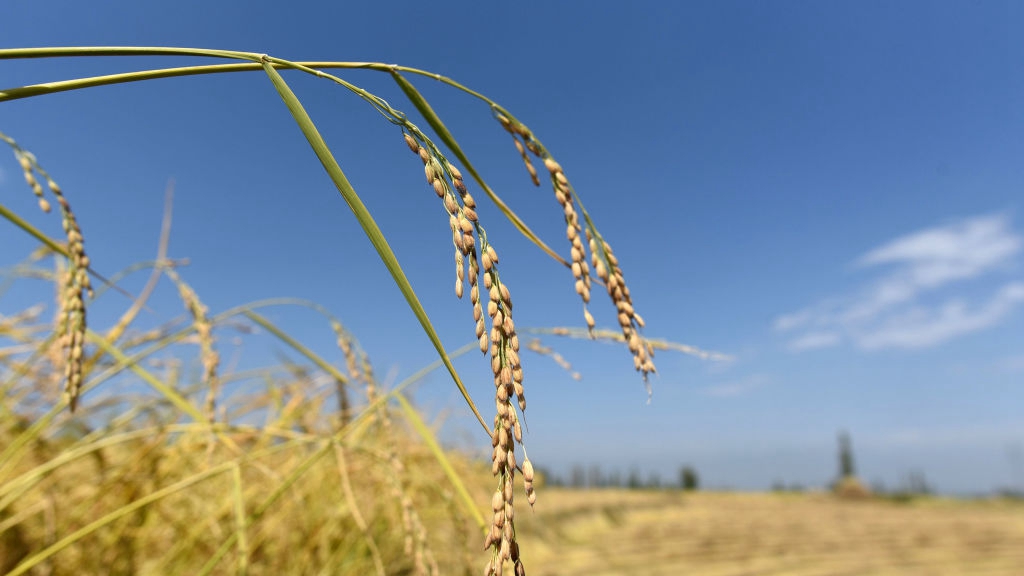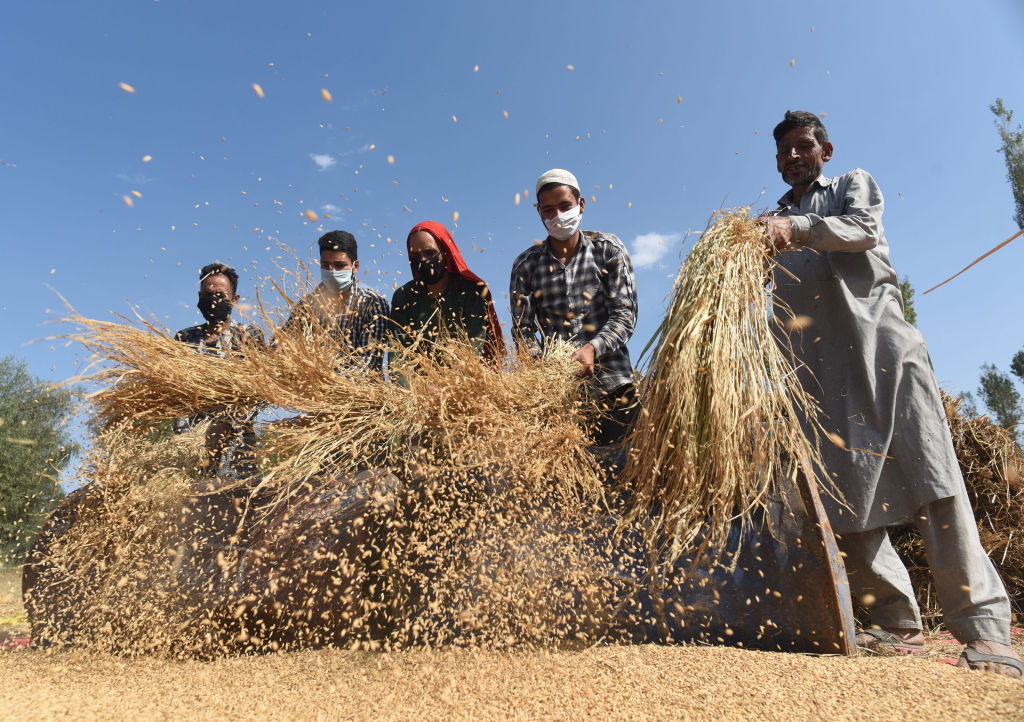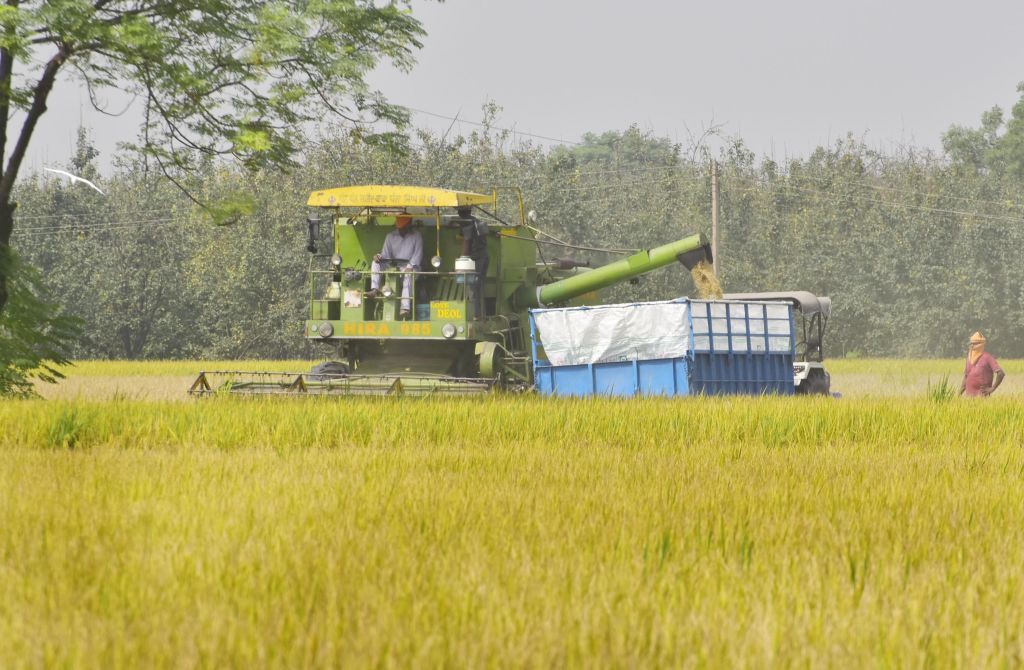
Paddy field at Tangmarg in the India-controlled part of Kashmir, September 30, 2020. /Getty Images
Paddy field at Tangmarg in the India-controlled part of Kashmir, September 30, 2020. /Getty Images
Editor's note: Alexander Ayertey Odonkor is an economic consultant, chartered financial analyst and a chartered economist with an in-depth understanding of the economic landscape of countries in Asia and Africa. The article reflects the author's opinions, and not necessarily the views of CGTN.
Data from the World Bank suggest that South Asia is home to the second largest proportion of the world's poorest people.
While in 2015, 80 percent of the region's entire population live on less than 5.50 U.S. dollars a day, about 49 percent of the total population in South Asia live on less than 3.20 U.S. dollars a day, in recent years, the population of the extreme poor living on less than 1.90 U.S. dollars in South Asia has declined from 536 million in 1990 to 275 million and 216 million in 2013 and 2015, respectively. Between 2010 and 2015, the region also recorded a 2.6 percent per year increment in the incomes of the poorest 40 percent, exceeding the global average of 1.9 percent.
However, beyond monetary requirements, growth in other indicators that determine the quality of living standards such as access to clean water and sanitation, affordable housing, electricity, education and food security has been comparatively low.
South Asia's Global Hunger Index (GHI) score for 2019 was 29.3, the highest in the world. The region's GHI point is heavily influenced by the high rate of child undernutrition; child wasting rate and child stunting rate is 17.5 percent and 37.6 percent, respectively, higher than any region in the world.
Factors such as poor nutrition among women before and during pregnancy, inadequate feeding of children and poor sanitation practices contribute significantly to the high levels of child stunting and child wasting in South Asia.
For a region that is expected to reduce extreme poverty to below three percent by 2030, the challenge associated with securing a higher standard of living for the people and eliminating all forms of poverty in the region has been a daunting task.
Highlights from a World Bank report indicate that agriculture driven-growth is two or three times more effective at reducing poverty in developing countries than an equivalent growth in other sectors. This is partly because a large percentage of the population in developing countries are engaged in agriculture.

Farmers thresh paddy during the harvest season at Tangmarg in outskirts of Srinagar, India, September 30, 2020. /Getty Images
Farmers thresh paddy during the harvest season at Tangmarg in outskirts of Srinagar, India, September 30, 2020. /Getty Images
In South Asia, a region that hosts Afghanistan, Bangladesh, India, etc, almost 60 percent of the entire population is involved in agriculture. With a population of about 1.8 billion, representing 25 percent of the world's total population and a land area of 5.2 million square kilometers, thus one percent of the world's land area, close to 57 percent of South Asia's land area is suitable for agriculture.
According to the World Bank, agribusiness, which also includes agriculture, accounts for about one-third of the region's Gross Domestic Product (GDP). The economic value for agribusiness in South Asia has the potential to reach 1.5 trillion U.S. dollars by 2030, which is twice the current value.
This projected growth in agribusiness will be driven largely by an accelerated transformation of the agriculture sector with the highest growth to be generated from processed food and other related services such as food retail and restaurants that will eventually create millions of indirect jobs from the agriculture sector.
Developing the agriculture sector has proven to be extremely effective in alleviating poverty in South Asia. For instance in Bangladesh, investments in agriculture have been pivotal in reducing poverty from 48.9 percent in 2000 to 31.5 percent in 2010.
Investments in mechanized farming, irrigation facilities and high-yielding crop varieties, enhanced by evidence-based policies that focus on human capital development, agriculture research and development of adequate infrastructure such as road networks has been the impetus for the decline in poverty in the country.
To boost agriculture-driven growth that could further reduce the rate of poverty in Bangladesh, policymakers and development partners should channel viable investments into developing the agriculture sector into a high-value sector.
Similarly, to further reduce poverty in South Asia via growth in the agriculture sector, policymakers and all relevant stakeholders should focus extensively on developing livestock production, poultry, horticulture and fisheries into high-value industries and robust rural economies.
The agriculture sector in the region is plagued with blanket regulations and trade policies that constraint sustainable growth, insufficient usage of agricultural technology and farming inputs such as high-yielding crops, fertilizer and water, a growing population that is straining the sector and waning profit of smallholder farmers.

A farmer on a combine harvester reaps paddy crop in a field at Jandiala Guru near Amritsar, India, September 30, 2020. /Getty Images
A farmer on a combine harvester reaps paddy crop in a field at Jandiala Guru near Amritsar, India, September 30, 2020. /Getty Images
With the largest proportion of agriculture production being rain-fed in South Asia, climate change exacerbates this egregious condition as smallholder farmers who constitute the largest percentage of farmers rely heavily on seasonal rainfall patterns to cultivate crops and feed livestock. A large percentage of the population of smallholder farmers who are mostly women do not have access to irrigation facilities on their farms.
This usually leads to a decline in crop yield which eventually has a negative impact on agriculture productivity and poverty alleviation as the income of these farmers diminishes. Adequate investments should be directed towards constructing irrigation facilities on farmlands, making available to farmers climate-resilient crops, mechanization of agriculture and providing other inputs such as fertilizers to farmers.
These resources are indispensable in stimulating agriculture productivity in the wake of climate change in the region.
Again, South Asia has recorded post-harvest losses for several decades and this perilous condition has a negative impact on income of farmers. According to the World Vegetable Center (WorldVeg), the annual post harvest losses in fruits and vegetables in India are estimated to be 32.7 billion U.S. dollars, representing a post-harvest loss of 30 percent per year.
As a result of the perishable nature of horticultural commodities, they are mostly exposed to a high degree of post-harvest losses as compared to other agricultural commodities. In South Asia, the provision of reliable storage facilities to preserve agricultural products could be a sustainable panacea for reducing perennial post-harvest losses, improving food security and alleviating poverty.
Also, removing all forms of trade barriers in the agribusiness industry could foster growth and eliminate poverty as a tolerable business environment in South Asia, will integrate all the markets in the region and provide an increased demand for agricultural goods which will ultimately create more jobs. It is important to note that excessive protectionist trade policies could hamper agriculture productivity, decrease economic growth and increase poverty levels.
Policymakers should frequently review trade policies and strategies as the agro-food sector in the region evolves. The successful implementation of these policies could enhance the eradication of poverty in South Asia.
(If you want to contribute and have specific expertise, please contact us at opinions@cgtn.com.)